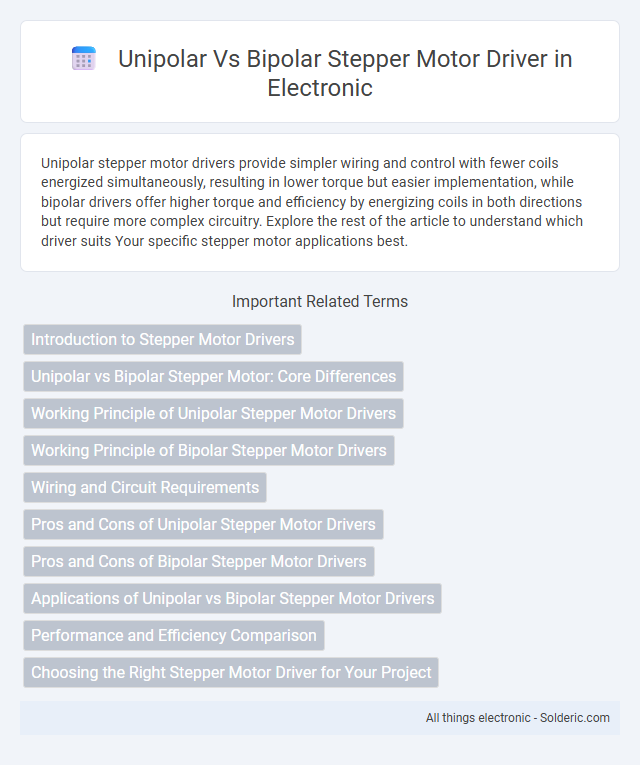Unipolar stepper motor drivers provide simpler wiring and control with fewer coils energized simultaneously, resulting in lower torque but easier implementation, while bipolar drivers offer higher torque and efficiency by energizing coils in both directions but require more complex circuitry. Explore the rest of the article to understand which driver suits Your specific stepper motor applications best.
Comparison Table
| Feature | Unipolar Stepper Motor Driver | Bipolar Stepper Motor Driver |
|---|---|---|
| Coil Configuration | Center-tapped coils, multiple winding taps | No center tap, full winding used |
| Current Flow | Current flows in one direction per coil | Current reverses direction in coils |
| Complexity | Simple circuit design | Requires H-bridge or complex driver circuitry |
| Torque | Lower torque output due to partial winding usage | Higher torque output using full coil windings |
| Efficiency | Less efficient; higher power loss | More efficient; better power utilization |
| Cost | Generally cheaper drivers | Usually more expensive drivers |
| Control | Simpler control signals | More complex control signals required |
| Applications | Low cost, low torque applications | High torque and precision applications |
Introduction to Stepper Motor Drivers
Stepper motor drivers control the current flow to precise coils in unipolar and bipolar stepper motors, enabling accurate position and speed regulation. Unipolar drivers energize one coil winding with a center tap, simplifying control but limiting torque, while bipolar drivers reverse current through the entire coil, providing higher torque and efficiency. Understanding the differences helps you select the right driver for your application's performance and control requirements.
Unipolar vs Bipolar Stepper Motor: Core Differences
Unipolar stepper motors feature a center-tapped winding that allows easier current direction control, making their drivers simpler and typically less expensive compared to bipolar drivers. Bipolar stepper motors have windings without center taps, requiring drivers capable of reversing current flow, which provides higher torque and efficiency for your applications. Choosing between unipolar and bipolar stepper motor drivers significantly impacts control precision, power consumption, and performance based on your specific needs.
Working Principle of Unipolar Stepper Motor Drivers
Unipolar stepper motor drivers operate by energizing one coil winding at a time, allowing current to flow through the center-tap of each coil, which simplifies the switching mechanism. This design eliminates the need for current reversal within the coils, enabling simpler and more cost-effective driver circuits compared to bipolar stepper motor drivers. The unipolar configuration results in straightforward stepping sequences, ideal for precise control with moderate torque output.
Working Principle of Bipolar Stepper Motor Drivers
Bipolar stepper motor drivers operate by reversing the current flow through the motor coils, enabling full coil utilization and generating stronger magnetic fields for higher torque output. These drivers use an H-bridge circuit to control the direction of current, allowing precise control over the motor's rotational steps. This bidirectional current control distinguishes bipolar drivers from unipolar drivers, which only energize one coil winding at a time.
Wiring and Circuit Requirements
Unipolar stepper motor drivers require simpler wiring, featuring six or eight lead wires with a common center tap for each coil, enabling ease of control with fewer transistors in the circuit. Bipolar stepper motor drivers use four lead wires without center taps and demand more complex circuitry, typically H-bridge configurations, to reverse current direction through the coils. Wiring complexity and circuit design directly influence driver efficiency and control precision in unipolar versus bipolar stepper motor applications.
Pros and Cons of Unipolar Stepper Motor Drivers
Unipolar stepper motor drivers offer simpler wiring and control due to their center-tapped coils, enabling easier implementation and generally lower cost. They typically draw less current per winding, reducing heat generation and increasing reliability in low to moderate torque applications. However, unipolar drivers deliver lower torque and efficiency compared to bipolar drivers, which may limit their suitability for high-precision or high-load stepper motor systems requiring your optimal performance.
Pros and Cons of Bipolar Stepper Motor Drivers
Bipolar stepper motor drivers provide higher torque and better efficiency compared to unipolar drivers due to their full current flow through the coils, making them ideal for applications requiring precise control and high power. However, bipolar drivers are typically more complex and expensive, requiring an H-bridge circuit to reverse current direction, which can increase system cost and complexity. If your project demands strong performance and precise motor control, a bipolar stepper motor driver will offer significant advantages despite its higher design requirements.
Applications of Unipolar vs Bipolar Stepper Motor Drivers
Unipolar stepper motor drivers are commonly used in applications requiring simpler control and lower power consumption, such as printers, small CNC machines, and basic automation systems. Bipolar stepper motor drivers excel in high-torque and precision applications like robotics, industrial machinery, and 3D printers due to their efficient current utilization and superior torque output. Choosing the right driver influences your device's performance, especially when balancing complexity, power needs, and accuracy.
Performance and Efficiency Comparison
Bipolar stepper motor drivers generally offer higher torque and better performance at lower speeds due to their ability to drive current through both coils in both directions, which increases magnetic field strength. Unipolar drivers are simpler and more efficient in terms of energy consumption but typically provide less torque and lower performance under high load conditions. Your choice depends on whether you prioritize torque and precision (bipolar) or simplicity and lower power usage (unipolar) in your application.
Choosing the Right Stepper Motor Driver for Your Project
Selecting the right stepper motor driver hinges on your project's torque, speed, and complexity requirements. Unipolar drivers offer simpler control with multiple coil windings, making them ideal for low-torque, cost-sensitive applications, while bipolar drivers provide higher torque and efficiency by utilizing full coil windings but require more complex control circuitry. Consider factors like voltage rating, microstepping capability, and current control features to optimize performance for robotics, CNC machines, or precision automation tasks.
unipolar vs bipolar stepper motor driver Infographic

 solderic.com
solderic.com